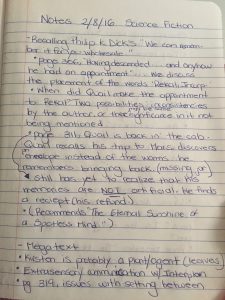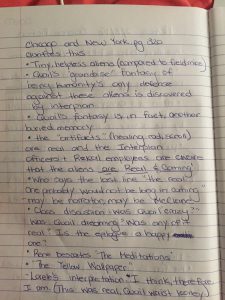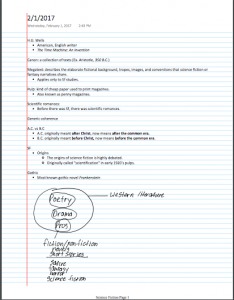We will be finishing up our discussion of Delany’s essay and short story next Monday. At that time, we will also discuss the excellent contributions to the SF Keywords definitions. I encourage you to read/re-read Delany’s essay and story, the notes below, the Delany posts, and the SF Keywords posts before our class next Monday.
February 22, 2017
“Time Considered as a Helix of Semi-Precious Stones” by Samuel Delany, which was published in the late 1960s, is a short story. The main character is a middle-ranked reluctant thief who simply wants to make a better living. HCE are the initials used consistently in the multiple names and identities attached to the protagonist and narrator. HCE as a woman meets Maud, who is an agent and wearing the stone of Jasper, which is a word, and he is not sure if he should approach her or not. Set in the future, in year –75 (space travel to Triton and Mars, three subways in NYC, three dimensional imaging/holographs, at least 500 years into the future (237)). Arty, Maud, Singer, HCE (at least three separate characters: the orphan boy named Harold Claney Everett growing up on a farm in Vermont, the small time crook named Hank Culford Eccles, the woman in the high heels named Harmony C. Eventide, big time Hector Calhoun Eisenhower. Ending appears to be unclear; no big finale. Consistent limited first person narrator. Most of the story takes place in a future NYC.
- 256: The whole plotof the story appears to be reflected in this passage because throughout the story, Maud has a problem with HCE becoming a big boss. Maud wants only one top level boss and many lower level thieves.
Crime does pay
Space travel
Digital imaging technologies
Questions:
1/ Why are the rising people the most dangerous?
2/ Why are the Singers so important?
3/ If HCE is always immersed in his new identities, how/why is he found?
“About 5, 750,” published in 1969? is an essay about how you can use different words to express the same thing and claims that there is no separation between style and content in fiction. The change of a single word in a 700 page novel could be important (2). Delany also emphasizes how each word revises the context of the words the precede it. Word choice matters to build up a story.
- 3:
D
Why might Delany’s style be important for writers and readers? 1/ For example, how might Delany’s ideas about writing influence other writers? How might they influence and affect readers?
2/ Is Delany’s style/ideas used by other science fiction writers/other fiction writers?
3/ How do you think the “structure” of someone’s writing affect the reader.
In “About 5, 750 Words,” D. argues that one’s choice of words matters. In “Time Considered a Helix of Semi-Precious Stones,” he appears to be putting into practice some of his ideas in “About 5, 750 Words.” It is important to notice the passage on p. 222.
What is the significance of the Singers?
What does the title mean?








